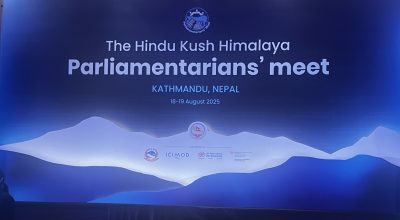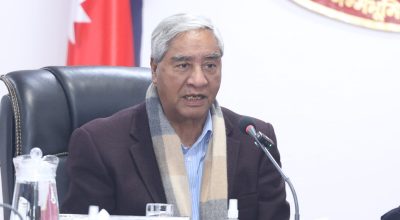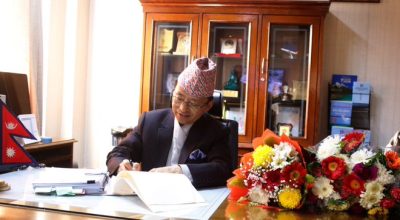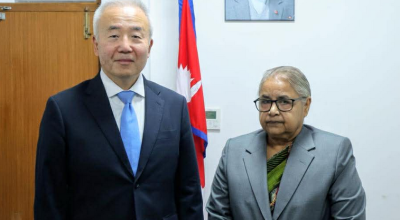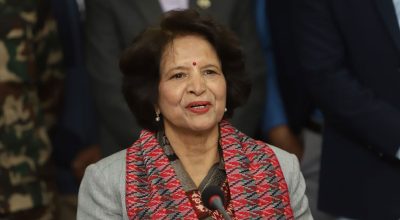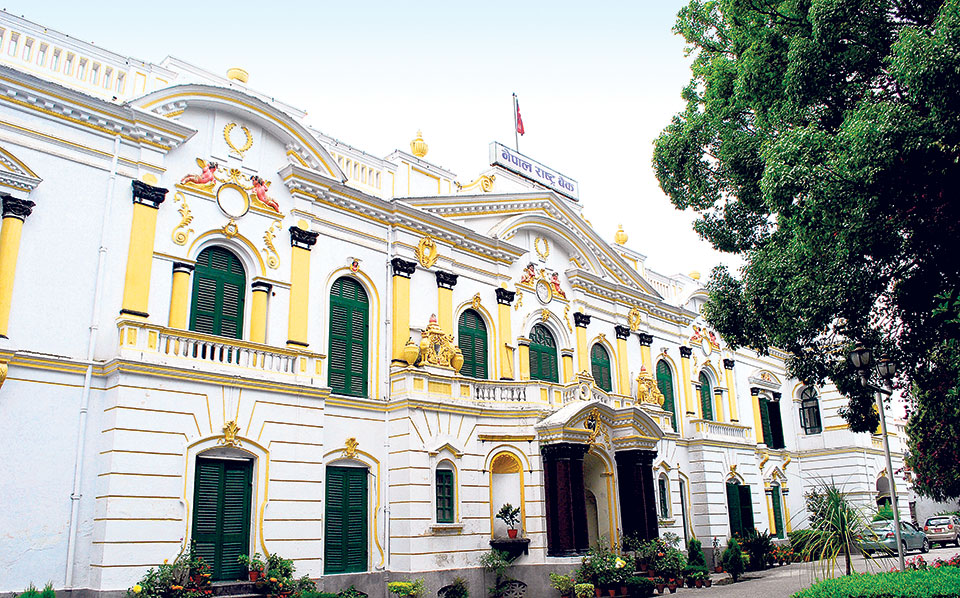
KATHMANDU: The country has recorded a huge trade deficit. In the first six months of the current fiscal year, Rs 880 billion trade loss was recorded by Nepal Rastra Bank (NRB).
In half-year report made public by the NRB on Wednesday, noticeable import is the reason behind soaring trade deficit. The trade loss in total goods is 46.6 percent. The loss however decreased by 5.8 percent as compared to the same period last year. In the review period, export-import ratio has reached 11.9 percent. It was 9.2 percent in the same period last fiscal.
In these six months, import of worth Rs 191 billion was made from India, while such import in same period of the last fiscal year was Rs 83.1 billion. However, export of total goods in these six months amounted to Rs 118 billion.
Major Highlights
- CPI-based Inflation remained 5.65 percent on y-o-y basis.
- Imports increased 51.1 percent and exports increased 95.5 percent.
- Remittances decreased 5.5 percent in NPR terms and 6.2 percent in USD terms.
- Balance of Payments remained at a deficit of Rs.241.23 billion.
- Gross foreign exchange reserves stood at USD 9.89 billion.
- Federal Government spending amounted to Rs.506.70 billion and revenue collection Rs.542.05
billion. - Broad money (M2) increased 2.8 percent. On y-o-y basis, M2 increased 14.3 percent.
- Deposits at BFIs increased 3.8 percent and claims on the private sector increased 12.0 percent.
- On y-o-y basis, deposits increased 15.5 percent and claims on the private sector 27.4 percent.
The y-o-y consumer price inflation stood at 5.65 percent in the sixth month of 2021/22 compared to 3.56 percent a year ago. Food and beverage inflation stood at 4.92 percent whereas non-food and service inflation stood at 6.23 percent in the review month.
The prices of ghee and oil; transportation; alchoholic drinks; tobacco products and pulses & legumes sub-categories rose 21.22 percent, 14.07 percent, 11.37 percent, 10.48 percent and 9.22 percent respectively on y-o-y basis.
In the review month, the Kathmandu Valley, Terai, Hill and Mountain witnessed 5.28 percent, 6.15 percent, 5.34 percent and 5.22 percent inflation respectively. Inflation in these regions was 3.55 percent, 2.87 percent, 4.72 percent and 3.38 percent respectively a year ago.
During the six months of 2021/22, merchandise exports increased 95.5 percent to Rs.118.85 billion compared to an increase of 6.1 percent in the same period of the previous year.
Destination-wise, exports to India and other countries increased 121.8 percent and 30.2 respectively whereas exports to China decreased 10.2 percent. Exports of palm oil, soyabean oil, oil cakes, juice, woolen carpets, among others, increased whereas exports of cardamom, tea, herbs, zinc sheet, wire, among others, decreased in the review period.
Remittances inflow down by 5.5 percent
Remittance inflows decreased 5.5 percent to Rs.468.45 billion in the review period against an increase of 11.1 percent in the same period of the previous year. In the US Dollar terms, remittance inflows decreased 6.2 percent to 3.93 billion in the review period against an increase of 6.7 percent in the same period of the previous year.
Number of Nepali workers (institutional and individual-new and legalized) taking approval for foreign employment increased significantly to 167,513 in the review period. It had decreased 89.0 percent in the same period of the previous year.
The number of Nepali workers (Renew entry) taking approval for foreign employment increased 298.1 percent to 130,212 in the review period. It had decreased 75.5 percent in the same period of the previous year.
Net transfer decreased 4.9 percent to Rs.523.01 billion in the review period. Such a transfer had increased 8.9 percent in the same period of the previous year.
Current account deficit by 345 billion
The current account remained at a deficit of Rs.354.07 billion in the review period compared to a deficit of Rs.51.68 billion in the same period of the previous year. In the US Dollar terms, the current account registered a deficit of 2.97 billion in the review period compared to deficit of 440.8 million in the same period last year.
In the review period, capital transfer decreased 20.0 percent to Rs.5.48 billion while net foreign direct investment (FDI) increased 48.1 percent to Rs.11.34 billion. In the same period of the previous year, capital transfer and net FDI amounted to Rs.6.85 billion and Rs.7.66 billion respectively.
Balance of Payments
Balance of Payments (BOP) remained at a deficit of Rs.241.23 billion in the review period against a surplus of Rs.124.92 billion in the same period of the previous year. In the US Dollar terms, the BOP remained at a deficit of 2.02 billion in the review period against a surplus of 1.05 billion in the same period of the previous year.
Foreign Exchange Reserves decreased by 16.7 percent
Gross foreign exchange reserves decreased 16.7 percent to Rs.1165.80 billion in mid-January 2022 from Rs.1399.03 billion in mid-July 2021. In the US Dollar terms, the gross foreign exchange reserves decreased 15.9 percent to 9.89 billion in mid-January 2022 from 11.75 billion in mid-July 2021.
Of the total foreign exchange reserves, reserves held by NRB decreased 18.4 percent to Rs.1015.59 billion in mid-January 2022 from Rs.1244.63 billion in mid-July 2021.
Reserves held by banks and financial institutions (except NRB) decreased 2.7 percent to Rs.150.21 billion in mid-January 2022 from Rs.154.39 billion in mid-July 2021. The share of Indian currency in total reserves stood at 24.5 percent in mid-January 2022.
Foreign exchange adequacy for 6.6 months only
Based on the imports of six months of 2021/22, the foreign exchange reserves of the banking sector is sufficient to cover the prospective merchandise imports of 7.2 months, and merchandise and services imports of 6.6 months.
The ratio of reserves-to-GDP (previous fiscal year), reserves-to-imports and reserves-to-M2 stood at 27.3 percent, 54.8 percent and 22.0 percent respectively in mid-January 2022. Such ratios were 32.8 percent, 84.7 percent and 27.1 percent respectively in mid-July 2021.






